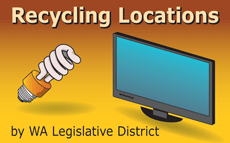
Medicines
The Problem: Disposal, Pollution, Poisonings, Abuse
Pharmaceutical use in the general population is common and growing. Nationwide the average 2006 prescription rate was 11.1 prescriptions per person, for a total of $192 billion in prescription sales according to Kaiser State Health Facts. Americans purchased 71% more prescriptions from 1994 to 2005, compared to a US population growth of 9% according to the Kaiser Family Foundation May 2007 Prescription Drug Trends Fact Sheet.
This means that more often than not, households have left over medications that they need to dispose of including prescription drugs, over the counter medications, free samples, Drug Enforcement Agency (DEA) controlled substances, and dietary supplements (vitamins).
Limited Options for Proper Disposal: Safe and proper disposal methods are currently not available to the consumer or family due to regulatory and financial barriers for take-back programs in the U.S. Therefore, people use the avenues of disposal available to them. Many households will store medications before they finally resort to flushing them down the toilet, disposing of them in the trash, or giving them to someone else.
Water Pollution: Pharmaceuticals enter the water when they are flushed down toilets and sinks, put into the garbage, or when humans and animals pass drugs through their bodies. Conventional wastewater treatment is not able to eliminate the majority of pharmaceutical compounds. Scientists are now finding chemicals from medicines in almost every sample taken from surface water, effluent, and drinking water in the U.S. and Canada.
Long Term Exposure: There is increasing concern about the disposal of medicines in the garbage which ends up at our landfills. Landfill runoff may be routed to treatment plants that don't effectively extract the chemical compounds from medicines and then it is discharged into our local waters. There is also concern that landfill liners may leak over time allowing contaminants to enter the ground water.
Poisoning: Medicines stored in our homes can lead to accidental poisonings if they are not securely stored. In the U.S., medications are the most common poison exposure category. The Centers for Disease Control reported that in 2004, 95% of unintentional and undetermined poisoning deaths were caused by drugs. In 2000, poisonings led to $26 billion in medical expenses and made up 6% of the economic costs of all injuries in the United States.
Misuse and Abuse: Prescription drugs, over the counter medications, and controlled substances are targets of drug users. Unsecured disposal in the garbage or at improper facilities may result in increased drug abuse or dealing. The National Center on Addiction and Substance Abuse found that the number of Americans who abuse controlled prescription drugs has nearly doubled from 7.8 million in 1992 to 15.1 million in 2003. Prescription drug abuse among teens has more than tripled during that time.
Product Stewardship Solutions
Product stewardship solutions include activities that manufacturers as well as retailers, governments and consumers can take to minimize the environmental and health impact of the product throughout all stages of the products' life cycle, including end-of-life management.
Take Back Programs: Unwanted medicines present both a public safety and environmental hazard if no secure disposal options exist. Therefore, a safe collection and disposal alternative is necessary. Ideally, residential customers should be able to take back unwanted medicines to local pharmacies, drug stores and other convenient locations so that they can be safely destroyed.
Legislation: Product stewardship legislation often requires that drug manufacturers provide funding for a statewide program to collection and safely dispose of unused medicines. The program cost could be incorporated into the price of the product for a few pennies per prescription. Residents would have access to convenient take back locations at pharmacies, drug stores and other locations. Local and state governments would provide oversight and would publicize the program.
